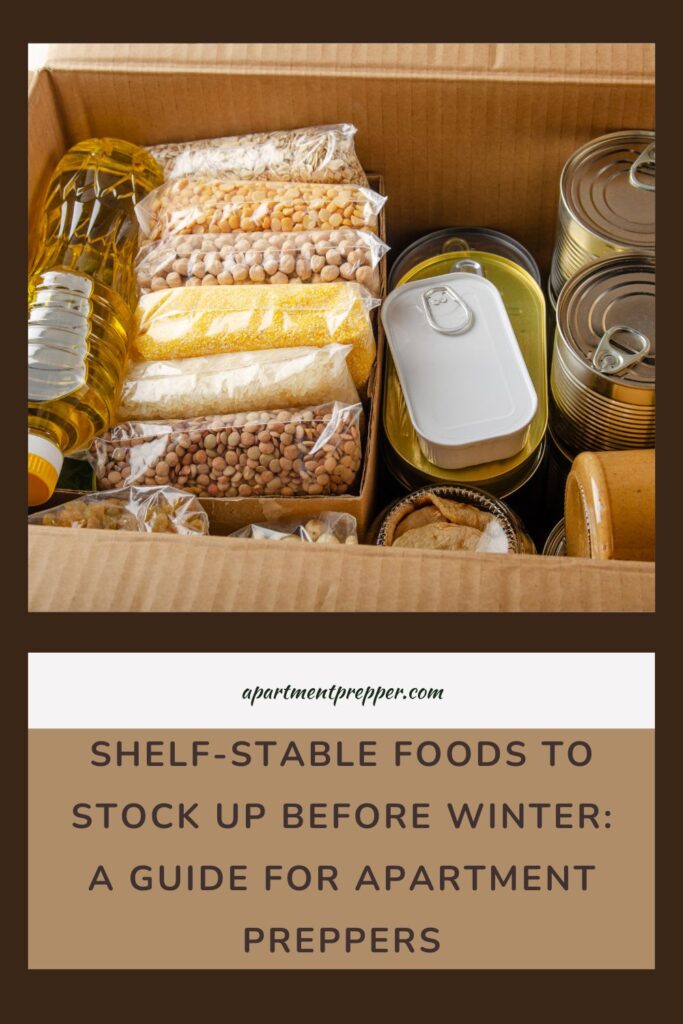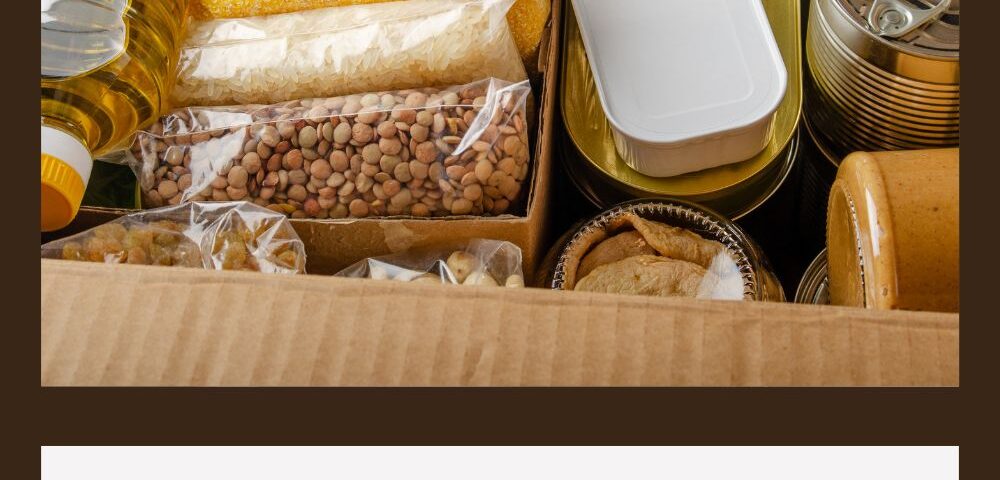Written by Bernie Carr
While doing my weekly grocery shopping I realized I need to stock up on some shelf stable supplies to replenish items I had used up. As winter approaches, it’s time to start thinking about stocking up on essential foods. Winter storms, power outages, and supply chain disruptions can all lead to limited access to fresh groceries. For apartment preppers, shelf-stable foods are a great way to stay prepared without requiring a lot of space. These foods don’t require refrigeration, have long shelf lives, and can keep you well-nourished if fresh foods become hard to access.
Here’s a guide on the best shelf-stable foods to stock up on before winter, along with some storage tips for small spaces.
1. Dried Beans and Lentils
Dried beans and lentils are a top choice for preppers. They’re affordable, full of protein and fiber, and easy to cook. A few pounds of dried beans can last a long time and provide enough food for multiple meals. While they do require cooking, they’re a perfect option if you have access to a stove. Lentils, in particular, cook faster than other dried beans, making them a great option if you want to save energy.
Storage Tip: Store beans and lentils in airtight containers to keep them fresh and prevent moisture.
2. Rice and Other Grains
Rice is a classic shelf-stable staple that’s versatile, long-lasting, and filling. White rice, in particular, has a very long shelf life when stored properly. Other grains like quinoa, barley, and oats are also excellent additions for variety and nutritional value. Quinoa is high in protein, while oats make for an easy breakfast or snack.
Storage Tip: Keep grains in sealed containers to protect against pests. Consider investing in vacuum-sealed bags for extended storage.
3. Canned Vegetables and Fruits
Canned vegetables and fruits are packed at peak freshness, making them a nutritious choice when fresh produce is scarce. Stock up on a variety of vegetables like green beans, corn, carrots, and peas. For fruits, opt for low-sugar or no-sugar-added options to keep things healthy.
Storage Tip: Store cans in a cool, dark place, and rotate your stock by using the oldest cans first.
4. Canned Meats and Fish
Protein is essential in any emergency, and canned meats and fish are some of the best shelf-stable sources available. Look for tuna, salmon, chicken, and even canned beef. I also really like sardines. Don’t knock it till you try it! Not only are these convenient, but they’re also packed with protein and healthy fats. Plus, they’re already cooked, so they can be eaten cold if necessary.
Storage Tip: Stack cans to maximize storage space. Canned meats have a long shelf life but still check expiration dates regularly.
5. Nut Butters
Peanut butter, almond butter, and other nut butters are nutrient-dense, packed with protein and healthy fats, and have a long shelf life. They’re great as a snack on their own, or spread on crackers or bread. Just a couple of jars can go a long way, and they don’t take up much space.
Storage Tip: Nut butters can separate over time, so choose the type that won’t need refrigeration after opening.
6. Shelf-Stable Dairy or Plant-Based Milk
Having a source of milk on hand is always helpful for cooking and drinking. Shelf-stable milk, whether dairy or plant-based, can last months unopened. Almond milk, soy milk, and other plant-based options are widely available and often fortified with vitamins. Powdered milk is also an option and can be a good backup if you run out of fresh milk.
Storage Tip: Once opened, shelf-stable milk needs to be refrigerated, so consider single-serving sizes if you don’t have a large fridge.
7. Pasta and Noodles
Pasta is another versatile, long-lasting staple that’s easy to store. It pairs well with canned sauces and doesn’t take up much room. Stock up on spaghetti, macaroni, and other types that you enjoy. You might also consider instant noodles for a quick meal option, though keep these for short-term use, as they tend to be high in sodium.
Storage Tip: Keep pasta in sealed containers to avoid exposure to humidity or pests.
8. Canned or Jarred Sauces
Tomato sauce, salsa, and even soups are all useful for making pasta dishes, stews, or casseroles. Canned and jarred sauces can add flavor and variety to meals with minimal effort. Some even have added vegetables, which boosts the nutritional value.
Storage Tip: Check expiration dates, as some sauces don’t last as long as other canned foods.
9. Dried Fruits
Dried fruits like raisins, apricots, and cranberries are packed with nutrients and are a great source of energy. They’re ideal for snacking or adding to oatmeal or yogurt. Dried fruits have a long shelf life and don’t require much space.
Storage Tip: Keep dried fruits in airtight bags or containers to maintain freshness. Watch for signs of moisture to prevent mold.
10. Instant or Ready-Made Meals
There are many options for shelf-stable, ready-made meals that only need hot water. Instant soups, noodle cups, and freeze-dried meals are convenient and require minimal preparation. Just make sure you have a source of hot water if the power goes out.
Storage Tip: Instant meals are compact, so store them in bins or under your bed if space is tight.
Storing Shelf-Stable Foods in a Small Apartment
In small spaces, creative storage is essential. Here are some ideas:
- Use Under-Bed Storage: This is an ideal place to store bulkier items like rice or water bottles.
- Add Overhead Shelving: Utilize vertical space for items you don’t use daily.
- Invest in Stackable Bins: Stackable bins or baskets can fit into small closets or even under tables.
- Maximize Cabinet Space: Organize your cabinets with risers to fit more cans and jars.
Rotate Your Stock and Check Expiry Dates
Remember to rotate your stock by using older items first and replacing them with new ones. Check expiration dates regularly, and try to incorporate these shelf-stable items into your daily meals to keep them fresh. This ensures you’re always ready, even when you don’t expect an emergency.
By stocking up on these shelf-stable foods before winter, you’ll be prepared for potential disruptions and can rest easy knowing you have a solid supply of nutritious meals on hand. Whether you’re weathering a storm or simply want to avoid last-minute grocery runs, these foods will serve you well through the colder months.
We are an affiliate of Amazon.com, which means we received a small commission if you click through one of our Amazon links when you shop, at totally no cost to you. This helps keep the lights on at the blog. Thanks!
About the author
Bernie Carr is the founder of Apartment Prepper. She has written several books including the best-selling Prepper’s Pocket Guide, Jake and Miller’s Big Adventure, The Penny-Pinching Prepper and How to Prepare for Most Emergencies on a $50 a Month Budget. Bernie’s latest e-book, FRUGAL DIY has just been released on Amazon. Her work appears in sites such as the Allstate Blog and Clark.com, as well as print magazines such as Backwoods Survival Guide and Prepper Survival Guide. She has been featured in national publications such as Fox Business and Popular Mechanics. Learn more about Bernie here.
FB: https://www.facebook.com/apartmentprepper
Instagram: https://www.instagram.com/apartmentpreppers/
Twitter: https://twitter.com/AptPrepper
YouTube: https://www.youtube.com/channel/UC7vOtdbo-wiBeBxD6puCr1Q
Patreon: https://patreon.com/apartmentprepper
Pinterest: https://www.pinterest.com/aptprepper/
Today’s societal climate not supportive of prepping. With your help, we can keep bringing you content that is often suppressed. Help keep Apartment Prepper alive.
Join me on Patreon for ad-free content.



